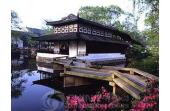Chengde
- Things to do
-
- Photo(84)
- Tips&article(114)
- Make it Happen
- Map
-
loading...
The little town Chengde gained its prominence during the Qing Dynasty when the emperors built a palace where they spend their summer months when the heat in Beijing became unbearable.
Chengde Summer Resort, together with the temples around, was added to the World Heritage List by UNESCO (United Nations Educational, Scientific, and Cultural Organization) in 1994. So far, many scenic attractions in Chengde have already been rated as 4-A class, highest level in this field in China.
Chengde has advantaged and abundant tourist resources. It has the world's largest royal hunting- the Mulan Paddock; the largest royal garden-the Summer Resort; the greatest royal temple group -the Eight Temples in the north of the Great Wall; the biggest wooden Buddha statue -the Kwan-yin Bodhisattva with a thousand hands and a thousand eyes, and the shortest river- the Hot River.
Chengde Summer Resort occupies a large area, incorporating countless buildings into natural setting of plains, mountains, lakes and islands to create an impressive scene which was praised by the emperor Kangxi, who reckoned its natural scenery more beautiful than the West Lake in Hangzhou Zhejiang province.
The Eight Temples in the north of the Great Wall around the Summer Resort is resplendent and magnificent. It fuses the architecture styles of the various nationalities in China such as Man nationality, Han nationality and Mongolian nationality to create buildings of multi-features.
The Mulan Paddock, familiar to many people, has been rated as a National Forest Park owning to its magic charm of a great grassland whose beauty was once described in a Chinese poem, like a peaceful and harmonious picture with a vast sky above, boundless grassland below and wind blowing the low grass then flocks and herds coming into view.
In the north of Chengde is Wulingshan Mountain Natural Reserve; in the west lies the No.1 Grassland for the purpose of spending one's holiday and in the east are Yuquanxing Palace and Liaohe River Holiday Zone.
Tips & articles
|
|
|
forum discussion
|
|
|










